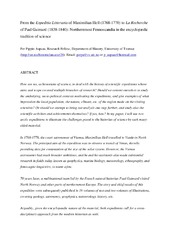"From the Expeditio Litteraria of Maximilian Hell (1768-1770) to La Recherche of Paul Gaimard (1838-1840): Northernmost Fennoscandia in the Encyclopædic Tradition of Science"
Author
Aspaas, Per PippinAbstract
How are we, as historians of science, to deal with the history of scientific expeditions whose aims and scope covered multiple branches of research? Should we content ourselves to study the underlying, socio-political contexts motivating the expeditions, and give examples of what impression the local population, the nature, climate, etc. of the region made on the visiting scientists? Or should we attempt to bring our analysis one step further, and study also the scientific activities and achievements themselves? If yes, how? In my paper, I will use two arctic expeditions to illustrate the challenges posed to the historian of science by such many-sided material. In 1768-1770, the court astronomer of Vienna, Maximilian Hell travelled to Vardø in North Norway. The principal aim of the expedition was to observe a transit of Venus, thereby providing data for computation of the size of the solar system. However, the Vienna astronomer had much broader ambitions, and he and his assistants also made substantial research in fields today known as geophysics, marine biology, meteorology, ethnography, and finno-ugric linguistics, to name a few. 70 years later, a multinational team led by the French natural historian Paul Gaimard visited North Norway and other parts of northernmost Europe. The story and chief results of this expedition were subsequently published in 16 volumes of text and two volumes of illustrations, covering geology, astronomy, geophysics, meteorology, history, etc. Arguably, given the encyclopædic nature of the material, both expeditions call for a cross-disciplinary approach from the modern historian as well.


 English
English norsk
norsk